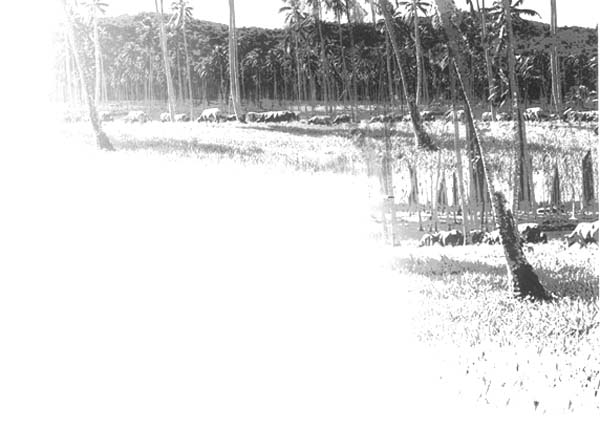
Summary
This chapter describes a broad framework for a multi-component regional grazing livestock improvement project. Such a project would focus on priority training for extension personnel, farmer and institutional management, and on the delivery of clear messages and adoptable technologies to farmers through the extension and training systems. It would also facilitate the provision of critically limiting development and marketing services to livestock farmers.
The chapter also outlines a series of 17 prioritised, non-forage-based initiatives that are considered essential for realising the potential for sustainable livestock subsector development in the Southwest Pacific. Some of these have been, or are in the process of being, project designed.
At the regional level
Enhanced animal production expertise to design, manage and monitor regional livestock development activities
Improved transfer of proven technology between countries
More regional training opportunities and a greater range of extension and training materials
Greater community awareness of the positive socio-economic, environmental and nutritional impact of improved grazing system technology
At the national level
Extension, training, awareness and adoption
Widespread farmer awareness of the potential for animal production and the technologies available to achieve this
Farmer competence in applying appropriate technologies
The extension process to remain demand based, unobtrusive and culturally appropriate
Adequate technical, planning, problem-solving, management and training skills among livestock extension personnel, as well as effective and sustainable extension and training delivery systems
Available and affordable pasture development services
National on-farm demonstration networks managed by key farmers working in farmer groups.
Farmer and industry support
Practical livestock baseline data and monitoring systems
Capacity for farmers to be able to acquire quality breeding stock
Adequate numbers of remote area meat butcheries; product choice and affordability; and consumer awareness of the nutritional value of various livestock products
Efficient processing, quality control and marketing of livestock products
Maintenance of non-limiting animal health status and disease surveillance, monitoring and response systems
Actual livestock production from forages approaching potential levels
Progress towards national self-sufficiency in livestock products
Important new development assistance initiatives have been identified for improving the productivity, profitability and sustainability of forage-based livestock production in the region.
Forage-based grazing systems production and marketing support
An integrated regional programme of development assistance is required if the levels of livestock product self-sufficiency identified in Chapter 4 are to be achieved. This regional programme, with specific country support components, should be designed to sustainably improve the subsistence, semi-commercial and commercial animal production from forage-based systems in Fiji, New Caledonia, Papua New Guinea, Samoa, Solomon Islands, Tonga and Vanuatu. Forage-based livestock production in the smaller island states would also benefit. It is suggested that this programme should focus on the four major components indicated below.
Component 1
Regional and country-specific training programmes for key, community-active farmers (around 250 trainees) and livestock extension personnel (around 300 trainees).
Component 2
Development of community-based, on-farm, problem-solving demonstrations (around 400 would be required across the major producing countries).
Component 3
Adequate numbers of farmer field days and organised farmer group activities, supported by the preparation and dissemination of information materials to reach the majority of farmers whose ruminant and non-ruminant livestock consume forages.
Component 4
Farmer access to important development services such as mechanised pasture establishment, cattle genetic improvement and remote area meat marketing, where these are limiting factors. Public awareness programmes to influence the consumption of local rather than imported livestock products would be included.

The relative importance of each of these components varies from country to country. A relatively developed country such as New Caledonia requires some modest support for Components 1 to 3. Samoa and Vanuatu have narrower and more specific needs: refresher training for livestock extension personnel in Vanuatu; raising pigs and poultry on locally available stockfeeds in both countries; and cattle genetic improvement in Samoa. Fiji, Papua New Guinea, Solomon Islands and Tonga require fully developed activities within each of the four components. It is estimated that a five-year regional project of this nature would cost in the order of US$4-5 million.
Other opportunities for development assistance
The regional analysis of issues and constraints described in previous chapters also suggests the need for a number of non-forage related initiatives, if livestock subsector development is to achieve its potential.
These can be broadly grouped as follows: livestock policy and strategy development, institutional and private sector human resource capability, survey and monitoring systems, agricultural extension systems, community awareness and livestock product marketing. The suggested regional programme would involve inputs into all of these areas, but complementary project assistance would be needed to address separately these important non-forage constraints in the livestock subsectors. They are presented in order of importance, as follows.1
Incorporation of livestock into all future farming systems projects
Most projects with a farming systems orientation in the region have excluded livestock, which is inconsistent given its importance at the household level.

Smallholders with one to five
cattle usually use tethering.
Country-specific training in policy and strategy development, and performance-based management training for livestock subsector institutions.
Many countries require assistance in developing subsector policies, strategies and corporate management plans of appropriate detail and timeframe. This needs to be linked to senior management training that focuses on leadership, programme planning, time and resource management, staff organisation and motivation.
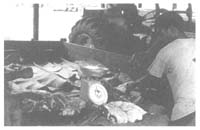
There are often inadequate
standards of hygiene in
district level meat processing
and retailing.
Improved livestock subsector information systems
Many countries require training and support in developing practical but statistically valid survey, monitoring, data processing and evaluation systems that provide reliable performance indicators for the livestock subsector. Output from quality surveys is essential for decision making on extension and rural development strategies and for sectoral equity in allocating scarce national recurrent budget resources for livestock.

Urban women at a training
session on improving family
nutrition through better
gardening and use of
livestock products.
Greater private sector involvement in meat processing
The lack of minimum standard slaughterhouses and retail outlets at the district level is restricting farmer incomes by failing to fully exploit opportunities for selling affordable meat to local consumers. Training in meat processing and in the construction and operations of such facilities is also required.
Regional community awareness programmes which encourage the use of locally produced livestock products rather than imports
While the promotion of livestock products occurs in some countries, a regular and professionally presented series of community awareness programmes on livestock products is required as part of awareness programmes on human nutrition.
Sustainable livestock genetic improvement programmes which involve the private sector
While inadequate feeding and management of livestock is the primary constraint to productivity, inbreeding and the use of inferior, poorly adapted bulls are major constraints in some countries.
Animal disease surveillance and reporting systems involving veterinarians, paraveterinarians, livestock officers, general extension officers and rural communities, and appropriate systems of response to confirmed outbreaks* FAO and SPC are supporting the development of a regional animal health information system. However, its usefullness will only be maximised if sustainable national animal disease surveillance and response systems are in place.
Eradication of specific production-limiting animal diseases which present a public health risk.
The localised risk of humans acquiring brucellosis or tuberculosis from infected meat or leptospirosis from cattle and pigs needs to be reduced or removed.

Tuberculosis in cattle lungs
Para-veterinary training across most countries, supplemented by training modules for meat inspection and quality control, public health, and animal quarantine
The Southwest Pacific has a low success rate in training veterinarians and in retaining them once they are trained. The STPLSP project has developed a successful para-veterinary training programme offered by a former Samoan veterinarian. In some countries there are inadequate meat inspection and animal quarantine skills, and in some cases the ultimate enforcement of meat processing and retailing standards rests with public health officers rather than meat inspection officers. This can lead to confusion and, effectively no enforcement of regulations.
Assistance for national development banks to improve their capacity to lend to creditworthy farmers and to provide farm-level technical, management and marketing support
Improved bank services will assist the physical and financial performance of farmer clients and reduce lending risk. The Papua New Guinea Rural Development Bank established an extension and advisory support subsidiary (SRPM Ltd.) to improve the quality and performance of its lending services. This model is relevant to other Southwest Pacific countries.
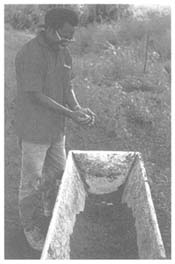
PNG cattle farmer uses copra
meal and molasses to
increase cattle growth.
Assistance to increase the use of locally grown or industrial by-product feeds for intensive livestock production
In some countries where by-products are competitively priced, supplementary feeding to augment pastures could produce major gains in ruminant production. Many local stockfeed manufacturers or farmers who mix their own rations, particularly for pigs and poultry, would benefit from specialist nutritional advice in making better use of locally available stockfeeds. In the case of Papua New Guinea and Fiji, the use of legumes in grain production systems along with improved crop nutrition and reduced tillage, would increase production.
Applied research and demonstration involving alternative densities and arrangements of coconuts in inter-cropped farming systems and nutritional limitations to livestock production
Coconuts will continue to be an integral part of many Southwest Pacific farming systems. However, farmers are interested in higher levels of transmitted light and more inter-cropping options. The potential for improved pastures, soil fertility amelioration and mineral and energy and protein supplementation to achieve animal production targets in representative agro-ecological zones requires applied research input.
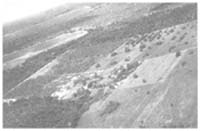
CIRAD Saraoutou Station on
Santo, Vanuatu, is a potential
centre for future coconut-based
farming system studies.
Assistance for rural women's groups and women entrepreneurs in developing pasture seed production businesses*
The Southwest Pacific could easily become self-sufficient in legume seed production. Women have consistently shown interest and diligence in seed production as it does not demand excessive time and provides supplementary income.
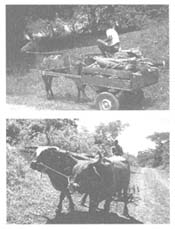
Horses and cattle used for
draught.
Practical training in the nutrition and management of cattle and horses for draught and transport
The Vanuatu Farm Support Association and the Montmartre Plantation Training Centre in Vanuatu are well placed to provide regional training in nutrition and management of horses for draught purposes. Fiji-based demonstrations of improved nutrition of draught oxen in increasing work output would also be beneficial to the sugar industry.
Farm business management training for larger private farmers (indigenes or citizens); training on responsibilities of board members in private agribusiness and government-controlled commodity marketing boards
Business management training needs for medium-to-large scale commercially motivated farmers tend to be overlooked by agencies concerned with small businesses. Personnel appointed to boards of agricultural companies and government agencies often lack prior business experience and understanding of the responsibilities of being a board member.
Targeted assistance for emerging dairy industries*
The success of small-scale dairying in the Southwest Pacific will depend on far greater emphasis on feeding and husbandry. However, expectations of production need to be realistic, given that high temperature and relative humidity reduce forage intake. FAO is currently providing some assistance for smallholder dairy development in Tonga and Samoa.
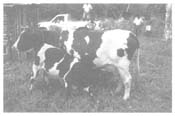
Smallholder dairy assistance
in Samoa.
Support for investigation within and outside the Southwest Pacific region of the trade possibilities for live animals and livestock products
Trade opportunities are often not fully exploited because product marketing from the Southwest Pacific is not undertaken with the quality and supply assurance and standard of professionalism that Asian and other importers require. Specific, timely support for securing premium niche markets will be required over the next decade, e.g. for certified organically produced beef ex Vanuatu).
1 Asterisked initiatives are already receiving some assistance.